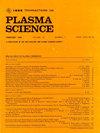水-空气- cu和水-空气- ni热等离子体净发射系数的计算研究
IF 1.5
4区 物理与天体物理
Q3 PHYSICS, FLUIDS & PLASMAS
引用次数: 0
摘要
由于温度梯度、物质密度及其分布的复杂性,热等离子体辐射的测定是一个非常复杂的问题。几种方法可以用来计算发射的辐射,基于各种方法,如几何,光谱,统计,以及计算模拟。本文介绍了水-空气- cu和水-空气- ni热等离子体混合物的净发射系数的计算。计算在等温、球形和均匀等离子体下进行,假设局部热力学平衡(LTE),压力高达10 atm,温度范围为300-30000 K。通过将原子连续体、分子连续体、原子线和分子带的各种贡献相加得到了NEC。结果强调了三个参数对NECs的影响:温度、压力和等离子体厚度。他们还证明了金属蒸气对低温等离子体辐射的重要作用,因为与水和空气中的中性物质O、H和N相比,中性的Cu和Ni的电离能较低。NEC的值允许估计等离子体热区的辐射损失,在数值模拟中,特别是用于激光诱导击穿光谱(LIBS)应用。本文章由计算机程序翻译,如有差异,请以英文原文为准。
Computational Study of the Net Emission Coefficient of H2O–Air–Cu and H2O–Air–Ni Thermal Plasma
The determination of the radiation emitted by thermal plasmas is a very complex problem due to the temperature gradients, species densities, and their complex distribution. Several methods can be used to calculate the radiation emitted, based on various approaches such as geometrical, spectral, statistical, as well as computational simulations. This article presents the computation of net emission coefficients (NECs) for thermal plasma mixtures of H2O–air–Cu and H2O–air–Ni. The calculations were performed for isothermal, spherical, and homogeneous plasmas, under the assumption of local thermodynamic equilibrium (LTE), at pressures up to 10 atm and over a temperature range of 300–30000 K. The NEC was obtained by summing the various contributions from atomic continua, molecular continua, atomic lines, and molecular bands. The results emphasize the impact of three parameters on the NECs: temperature, pressure, and plasma thickness. They also demonstrate the crucial importance of metallic vapors on low-temperature plasma radiation owing to the low ionization energy of neutral Cu and Ni compared to the neutral species O, H, and N present in H2O and air. The values of NEC allow for the estimation of radiative losses in the hot zones of the plasma, in numerical modeling, especially devoted to laser-induced breakdown spectroscopy (LIBS) applications.
求助全文
通过发布文献求助,成功后即可免费获取论文全文。
去求助
来源期刊

IEEE Transactions on Plasma Science
物理-物理:流体与等离子体
CiteScore
3.00
自引率
20.00%
发文量
538
审稿时长
3.8 months
期刊介绍:
The scope covers all aspects of the theory and application of plasma science. It includes the following areas: magnetohydrodynamics; thermionics and plasma diodes; basic plasma phenomena; gaseous electronics; microwave/plasma interaction; electron, ion, and plasma sources; space plasmas; intense electron and ion beams; laser-plasma interactions; plasma diagnostics; plasma chemistry and processing; solid-state plasmas; plasma heating; plasma for controlled fusion research; high energy density plasmas; industrial/commercial applications of plasma physics; plasma waves and instabilities; and high power microwave and submillimeter wave generation.
 求助内容:
求助内容: 应助结果提醒方式:
应助结果提醒方式:


